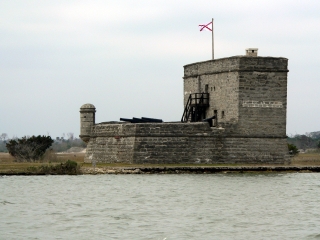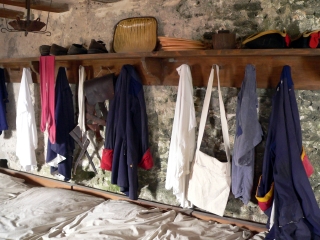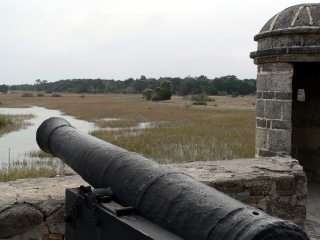NPS Website; Local Website
 WHAT IS IT?
WHAT IS IT?A Spanish stone masonry fortification finished in 1742 whose purpose was to guard the mouth of the Matanzas River, a back door channel into the important colonial city, Saint Augustine.
BEAUTY (6/10)
Fort Matanzas stands on Rattlesnake Island, a small piece of land that bisects the mouth of the Matanzas River. The surrounding waters are much calmer than the nearby Atlantic Ocean.
The fort sits around estuarine marshlands and enjoys a typical Florida coastal feel. The building, itself, is very small. Only seven soldiers lived here at its most crowded. Five cannons point upstream from the deck-like perch. These soldiers lived in a narrow one-room deck level enclosure, while the officers lived directly above.
The Fort has a functional charm. There are no wasted bricks and no superfluous space.
HISTORICAL INTEREST (5/10)
The Spanish built Fort Matanzas because of its strategic defensive position. The Fort faced its first test in 1742, while it neared completion. James Oglethorpe, Governor of the British colony of Georgia, led 12 ships into the Inlet, in an effort to attack St. Augustine from the rear. Fort Matanzas’ cannons repelled the attack and never saw battle again.
As a fort, this Site has limited historical significance. However, nearly 200 years before Fort Matanzas’ construction, another more important historical event occurred on these lands; an event that solidified Spain’s 200-year colonial rule over Florida and ensured the safety of their trade routes.
In 1565, the Spanish looting of South America was in full swing. Boat after treasure-filled boat sailed from Cartagena, Columbia or Vera Cruz, Mexico on to the Spanish capital city, Havana, Cuba up the Gulf Stream and over to Spain. These treasure ships passed close to the shores of present-day Florida.
In 1564, Protestant French (Huguenots) built Fort Caroline near present-day Jacksonville and began to raid the Spanish galleons for their treasure. The devoutly Catholic Spanish resented the French infidels’ religious choice and their brazen theft. In August 1565, the Spanish founded the town of St. Augustine to subdue the French and protect their ships.
In September, after receiving reinforcements, the French decided to attack St. Augustine en masse leaving Fort Caroline virtual defenseless. Instead of a swift victory, their ships were caught in a hurricane that wrecked the boats and swept the men far south of the new Spanish city. The Spanish caught up with the Huguenots at the mouth of the soon-to-be named Matanzas River.
After the unarmed and exhausted French surrendered, the Spanish bound and then killed all but 16 of the 350 Huguenots. Matanzas is the Spanish word for slaughter. St. Augustine flourished and the French never again gained a foothold in this area of North America.
 CROWDS (5/10)
CROWDS (5/10)We shivered alongside more tourists than we had expected. Our layered clothing, wool hats and gloves spoke the same question: Didn’t we all leave the Northern winter to avoid this?
EASE OF USE/ACCESS (4/5)
The Site is located just a few miles east of Interstate 95 on the Florida A1A, 14 miles south of St. Augustine. A ferry to the Fort site departs from the Visitor Center hourly on the half hour. The ferry is free and reliable. We arrived on an unseasonably cold and windy day but unlike the violent Atlantic Ocean, the Matanzas River Inlet was calm. Wind whipped against our faces but the ride was short and sweet.
CONCESSIONS/BOOKSTORE (2/5)
We would have appreciated a larger bookstore to browse as we waited for the next ferry. Space is tight, especially if more than one person is perusing the shelves. Titles like A Taste of St. Augustine and Famous Florida Recipes, although not directly related to the site, add flavor to the small selection. Books on famous Florida ship wrecks and the Spanish treasure fleets were more appropriate reading companions to a visit to Fort Matanzas. Samples of coquina, one of the materials used to build the Fort, are scattered around the little shop.
COSTS (5/5)
The Site, ferry ride and the tour of the Fort are all free.
RANGER/GUIDE TO TOURIST RATIO (5/5)
We encountered a plethora of Rangers. Three Rangers and two volunteers accompanied our group on the ferry to the Fort site. No one could have any excuse for leaving the Site with an unanswered question.
TOURS/CLASSES (6/10)
All boat trips to Rattlesnake Island include a 25-minute long talk about the Fort. Because of the cold, the volunteer gave his entire talk in the long, narrow soldiers’ quarters. We were allowed to explore the other room, the deck and the roof when the talk ended. The lesson was informational and nice background to a tour of St. Augustine and its fort, the Castillo de San Marcos.
A tour of Fort Matanzas is an essential companion piece to a Fort Caroline NM visit. Fort Caroline NM has no Ranger talks and no interpretive panels. If you want an understanding of its historical role, you almost need to visit Fort Matanzas.
There are no Museum facilities at Fort Matanzas NM. If you arrive at 10:35am, for example, you will have to deal with idle time. The short introductory video is dated and confusing and the mile long Nature Walk loop is under construction.
FUN (5/10)
We weren’t expecting a boat ride to be involved in our visit, which is what happens when you read a guidebook too quickly. The fact that it was free and left every 30 minutes warmed us to the idea. The Fort was charming; the ferry was fast. A Ranger might have given a more extensive explanation of the events around the building and use of Fort Matanzas. But the volunteer who led our tour won us over with his Pittsburgh accent and the fact that he is the second person on our trip that recognized the B on Gab’s hat. Brownie points for that.
 WOULD WE RECOMMEND? (5/10)
WOULD WE RECOMMEND? (5/10)On a nice sunny day, we are sure the ferryboat trip to Fort Matanzas makes for a lovely day. However, it is not a big-ticket historical destination like nearby St. Augustine and the Fort is awful small. Our freezing bones are still screaming at us for leaving Miami. This Site is for history buffs and those eager to learn everything about Spanish colonial history. We are glad we traveled to Fort Matanzas NM prior to St. Augustine because it provided a good base of understanding for the intensive lesson the old city provides.
TOTAL 48/80
www.usa-c2c.com
© 2004-06